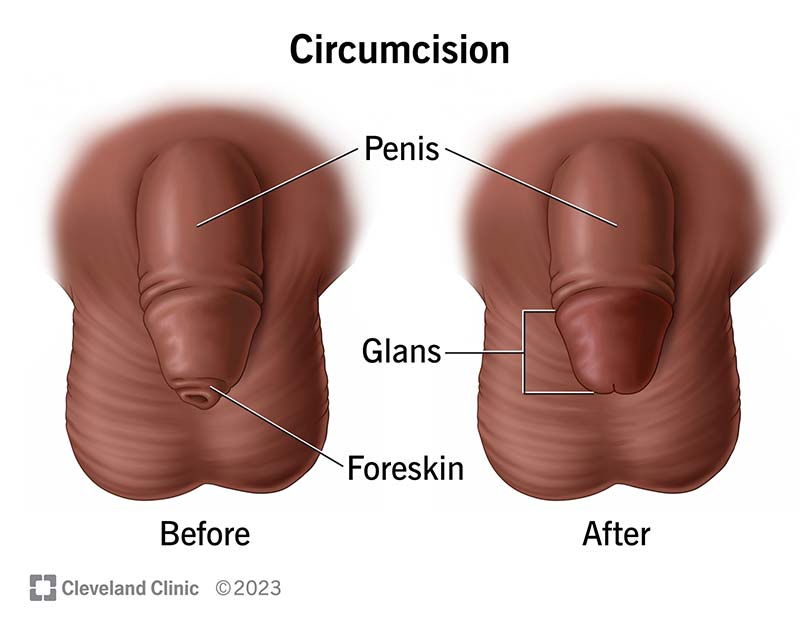Surgical Removal of the Foreskin
Circumcision is a surgical procedure performed to remove the foreskin—the retractable fold of skin that covers the head (glans) of the penis. This is a routine procedure with both medical and personal indications, performed safely under anaesthesia.
Who Is Circumcision Suitable For?
Circumcision may be medically recommended for men who:
- Have phimosis – a condition where the foreskin is too tight to retract
- Have paraphimosis – when the retracted foreskin cannot return to its normal position, often causing pain and swelling
- Experience recurrent balanitis – inflammation or infection of the foreskin
Circumcision may also be considered for personal, cultural, or religious reasons. It is important to discuss your decision with your doctor to understand the benefits and potential risks.

Who Is Circumcision Suitable For?
Circumcision may be medically recommended for men who:
- Have phimosis – a condition where the foreskin is too tight to retract
- Have paraphimosis – when the retracted foreskin cannot return to its normal position, often causing pain and swelling
- Experience recurrent balanitis – inflammation or infection of the foreskin
Circumcision may also be considered for personal, cultural, or religious reasons. It is important to discuss your decision with your doctor to understand the benefits and potential risks.
Benefits of Circumcision
- Relieves symptoms associated with phimosis, paraphimosis, and balanitis
- Reduces the risk of recurrent foreskin infections
- May improve hygiene and comfort
How Is Circumcision Performed?
- Circumcision is usually performed under general anaesthetic, although local anaesthetic may be used in select cases
- The procedure typically takes around 45 minutes
- The excess foreskin is carefully removed, and the remaining skin is sutured for a neat and functional result
- Dissolvable stitches are used to close the wound
What to Expect After Surgery
- Circumcision is generally performed as a day procedure
- Light activity can be resumed the following day
- Strenuous activity and sexual activity should be avoided for 4–6 weeks
- Common side effects include:
- Bruising and swelling of the penis
- Pain or a burning sensation when urinating
- Discomfort from nocturnal (night-time) erections
These symptoms typically improve over 2–3 weeks.
Procedure Outcomes
- Circumcision is highly effective for treating foreskin-related conditions
- Most men heal well with minimal long-term complications
- In rare cases, mild loss of sensitivity may occur, which could affect sexual function
- Your urologist will discuss all risks, benefits, and expected outcomes with you prior to surgery
Post-Operative Care Instructions
What to Expect:
- Local anaesthetic used during surgery may wear off within a few hours—mild discomfort is normal
- Some bleeding from the wound is expected for a few days
- Try to leave dressings in place for 24–48 hours, or as instructed
- Swelling, redness, and increased sensitivity are common and typically settle within 6 weeks
- Stitches are dissolvable and may take up to three months to fully disappear
Return to Activity
- Driving: Avoid for at least 24 hours or until you feel fully comfortable
- Work: Most patients need at least 1 week off—your occupation may influence this
- Lifting: Avoid heavy lifting for 2 weeks
- Exercise: Walking is encouraged, but avoid strenuous activity for 4 weeks
- Sexual Activity: Avoid for 4–6 weeks, or until cleared by your surgeon
Pain Management
- Use prescribed pain relief, or take ibuprofen or paracetamol as needed
- Ural sachets (available over-the-counter) may help relieve discomfort with urination
When to Seek Medical Attention
Contact your nearest hospital emergency department if you experience:
- Heavy or uncontrolled bleeding
- Rapidly increasing swelling at the wound site
- Inability to pass urine
- Fever, chills, or shakes, which may indicate infection
Follow-Up Care
Our rooms will arrange a follow-up appointment with your urologist, typically 6–8 weeks after surgery, to review your healing and discuss any concerns.
